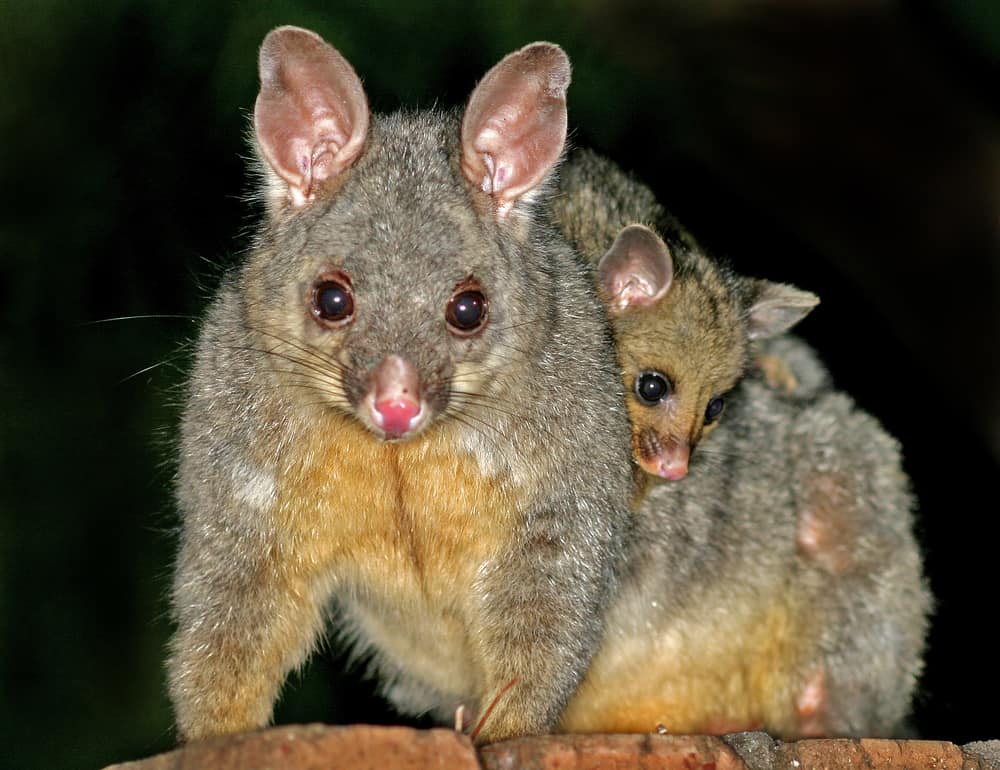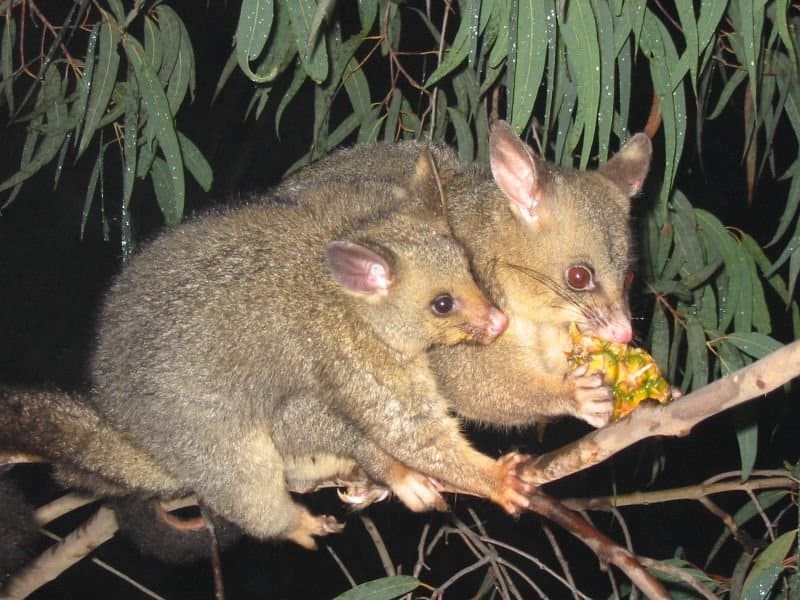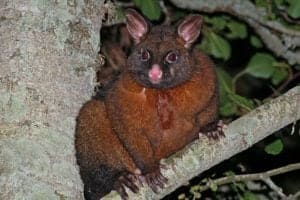When you see a possum scurrying along a tree branch or peering down from a rooftop, you may not be aware that it could be carrying passengers. After all, possums aren’t kangaroos; they don’t have adorable joeys peeking out of pouches on their bellies. Or do they? If you’re like most people, you’ll have a hard time figuring that out on sight. So do possums have pouches or not? Read on to discover the answer!
What Do You Call an Animal with a Pouch?
A marsupial is a type of mammal with a furred pouch on its belly for carrying its young after birth. This stands in contrast to the other two types of mammals, placental and monotreme. Like all other mammals, marsupial mothers nurse their young with their own milk. Currently, there are 335 species of marsupials in the world.
Unlike pouched mammals, placental mammals fully develop their babies in the womb before giving birth to live young. While in the womb, the young receive nutrition from their mothers via the umbilical cord. After birth, they suckle milk from their mother’s teat until they are mature enough to consume other sources of nutrition. The vast majority of mammals are placental.
Monotreme mammals, on the other hand, are not live-bearing. They lay eggs, which then hatch after a period of approximately 10 days. Though monotremes nurse their young, they do not have teats. Instead, they secrete milk from their mammary glands through folds in their skin. The young then lap the milk from these folds. There are only five extant species of monotremes: the duck-billed platypus and the four species of echidnas.
Do Possums Have Pouches?

Female possums have pouches for carrying their young after birth.
©Stuart Elflett/Shutterstock.com
As marsupials, all female possums have pouches. However, these pouches are smaller than those of other marsupials like kangaroos and koalas, making them more difficult to spot. This adaptation enables possums to hide their young more effectively from predators. Baby possums, called joeys, are tiny at birth and consequently need very little room. Newborn possum joeys typically measure less than an inch in length and weigh only a fraction of an ounce!
Australia and the surrounding islands are home to 69 different species of possums, including pygmy possums and gliders. Possums are distinct from opossums, which are also marsupials but inhabit North, Central, and South America. Gliders are possums that glide through the air much like a flying squirrel. Examples of different Australian possum species include:
- Common brushtail possum (Trichosurus vulpecular)
- Common ringtail possum (Pseudocherius peregrinus)
- Mountain pygmy possum (Burramys parvus)
- Scaly-tailed possum (Wyulda squamicaudata)
- Striped possum (Dactylopsila trivirgata)
- Feathertail glider (Acrobates pygmaeus)
- Yellow-bellied glider (Petaurus australis)
What Do Possums Use Their Pouches For?

Possums’ pouches are difficult to spot without a close examination.
©Bryce McQuillan, CC BY-SA 2.0, via Wikimedia Commons – License
Possums use their pouches to keep their joeys safe during their development. Unlike the young of placental mammals, which develop in the womb before birth, marsupial young are born underdeveloped. In fact, possum joeys have very little natural immunity at birth as their immune systems haven’t progressed to that point. The pouch provides a safe haven from the diseases and dangers of the world around them, acting as a sort of external immune system.
Before joeys can leave their mother’s pouch, they must mature enough to survive without its protection. In this sense, marsupials’ pouches act as a second womb, fostering the continued growth and development of their young.
From the Birth Canal to the Pouch
The first thing possum babies do upon being born is seek the safety of their mother’s pouch. They don’t require her help to do this; the instinct is innate. As soon as they exit the birth canal, the tiny pink joeys begin the upward crawl to the pouch on their mother’s belly. They make a beeline for one of two teats within the pouch and latch on. Through the teat, the mother provides her joeys with all the nutrition they need while in the pouch.
Though most possum species only give birth to one to two joeys at a time, occasionally the litter is bigger. In this case, the number of joeys outnumbers the available teats. In many cases, joeys actually fuse onto the teat, refusing to relinquish their grip as long as they’re in the pouch. Sharing is therefore out of the question. The strongest joeys make it to the pouch first and claim a teat. If there are more joeys than teats, the weakest in the litter do not have a source of nutrition and eventually die.
Are Baby Possums Blind?
Baby possums are blind from birth and almost completely helpless. They make their way to their mother’s pouch by smell and feel. In fact, this is virtually the only thing they are capable of doing on their own.
There is a common misconception that possum adults are blind. This is false both for Australian possums and opossums in the Americas. One opossum species, the Central American woolly opossum, actually has incredibly keen eyesight! However, this popular misconception has some basis in reality. Though possums are not blind as adults, most species have poor eyesight due to their permanently dilated pupils. As a result of this curious adaptation, they see much better at night than during the day.
How Long Do Possum Joeys Stay in Their Mother’s Pouch?

After possum joeys leave the pouch, they cling to their mother’s back as she moves around.
©Peter Firminger / CC BY 2.0, Flickr – License
Possum joeys stay in their mother’s pouch for approximately four to five months, as in the case of the common brushtail possum. During this time, they remain completely hidden from sight. The teat acts as a kind of external umbilical cord to provide a constant source of nutrition. The pouch expands as the joeys grow in size.
After this period, the joeys have developed enough to leave the pouch and enter the outside world. During this time, they often cling to their mother’s back as she moves around. They remain with her for the next few months. Common brushtail possums, for example, usually leave their mothers by seven to nine months of age, though they may not have reached their full size by this point.
Possum Gestation Period
The gestation period for most possums is 16-17 days. This relatively brief period does not include the time spent by joeys in their mother’s pouch. During pregnancy, female possums seek the shelter of tree hollows or the insides of houses. Once the joeys are born, the males of most possum species have no involvement with the young. The only exception is the common ringtail possum, which is unusually gregarious. Males of this species take an active part in raising the young, including ferrying them around on their backs.
Though you might have a hard time seeing it from a distance, female possums do indeed have pouches for carrying their young. Don’t try to get too close, though: these marsupials like to keep their distance!
The photo featured at the top of this post is © Timothy Christianto/Shutterstock.com
Thank you for reading! Have some feedback for us? Contact the AZ Animals editorial team.






